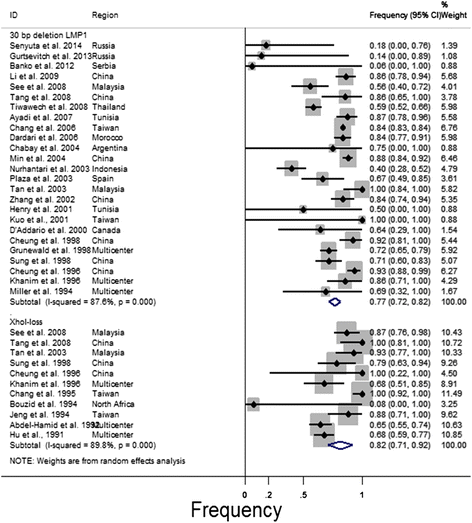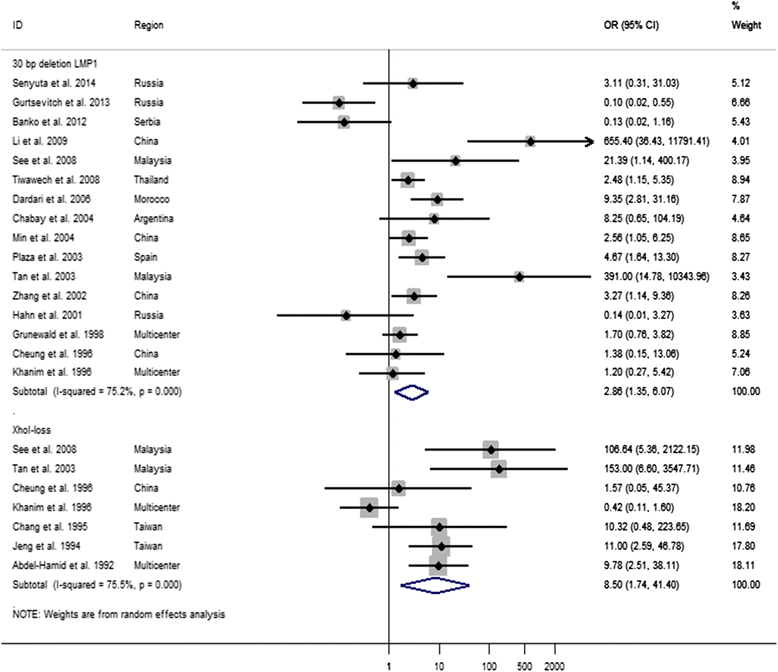The Epstein-Barr virus latent membrane protein-1 (LMP1) 30-bp deletion and XhoI-polymorphism in nasopharyngeal carcinoma: a meta-analysis of observational studies
- PMID: 25927427
- PMCID: PMC4404015
- DOI: 10.1186/s13643-015-0037-z
The Epstein-Barr virus latent membrane protein-1 (LMP1) 30-bp deletion and XhoI-polymorphism in nasopharyngeal carcinoma: a meta-analysis of observational studies
Abstract
Background: Epstein-Barr virus (EBV) is considered to be closely associated with nasopharyngeal carcinoma (NPC), in which EBV-encoded latent membrane protein 1 (LMP1) was found to have an oncogenic role. However, the results published on the LMP1 polymorphism are inconsistent. In the present study, we performed a meta-analysis to determine the frequency of the associations and a more precise association between NPC and EBV LMP1 gene variants (30-bp deletion (del)/XhoI-loss).
Methods: Eligible articles met the inclusion/exclusion criteria and were identified in the following electronic databases: PubMed, ScienceDirect, and SciELO. Consequently, the data of interest were extracted and plotted in a table to calculate the frequency and odds ratio (OR) of the outcomes of interest (30-bp del-LMP1/XhoI-loss) in patients with NPC. Study quality (Newcastle-Ottawa Scale (NOS)), publication bias, and heterogeneity were assessed.
Results: Thirty-one observational studies were included with a total of 2,846 individuals (NPC, n = 1,855; control, n = 991). The risk of bias in relation to study quality evaluated by NOS was considered low. The pooled estimate of the frequency of 30-bp del-LMP1 and XhoI-loss in patients with NPC was 77% (95% confidence interval (CI): 72 to 82) and 82% (95% CI: 71 to 92), respectively. There was an association between 30-bp del-LMP1 and NPC susceptibility (OR = 2.86, 95% CI: 1.35 to 6.07, P = 0.00). Similarly, there was an association between XhoI-loss and NPC (OR = 8.5, 95% CI: 1.7 to 41, P = 0.00). However, when we analyze the co-existence of the 30-bp del-LMP1 and XhoI-loss in patients with NPC, there was no association (OR = 1.09, 95% CI: 0.06 to 18.79, P = 0.002).
Conclusions: Our results suggest an association between the 30-bp del-LMP1 and XhoI-loss with NPC susceptibility. However, our data should be interpreted with caution because the sample size was small, and there was heterogeneity between the studies. Thus, future studies are needed with adjusted estimates to simultaneously evaluate multiple factors involved in the development of NPC.
Systematic review registration: PROSPERO CRD42014013496 .
Figures



Similar articles
-
Epstein-Barr virus latent membrane protein-1 (LMP-1) 30-bp deletion and Xho I-loss is associated with type III nasopharyngeal carcinoma in Malaysia.World J Surg Oncol. 2008 Feb 15;6:18. doi: 10.1186/1477-7819-6-18. World J Surg Oncol. 2008. PMID: 18275617 Free PMC article.
-
[Study of sequence variations of Epstein-Barr virus LMP1 gene in nasopharyngeal carcinoma].Zhonghua Bing Li Xue Za Zhi. 2005 Dec;34(12):791-5. Zhonghua Bing Li Xue Za Zhi. 2005. PMID: 16545188 Chinese.
-
[Analysis of Epstein-Barr virus with BamHI "f" variant and XhoI-loss of LMP1 gene in nasopharyngeal carcinoma].Zhonghua Bing Li Xue Za Zhi. 2003 Dec;32(6):534-8. Zhonghua Bing Li Xue Za Zhi. 2003. PMID: 14761599 Chinese.
-
Pathogenic role of Epstein-Barr virus latent membrane protein-1 in the development of nasopharyngeal carcinoma.Cancer Lett. 2013 Aug 28;337(1):1-7. doi: 10.1016/j.canlet.2013.05.018. Epub 2013 May 17. Cancer Lett. 2013. PMID: 23689138 Review.
-
Novel roles and therapeutic targets of Epstein-Barr virus-encoded latent membrane protein 1-induced oncogenesis in nasopharyngeal carcinoma.Expert Rev Mol Med. 2015 Aug 18;17:e15. doi: 10.1017/erm.2015.13. Expert Rev Mol Med. 2015. PMID: 26282825 Review.
Cited by
-
Characterization and Establishment of a Novel EBV Strain Simultaneously Associated With Nasopharyngeal Carcinoma and B-Cell Lymphoma.Front Oncol. 2021 Apr 7;11:626659. doi: 10.3389/fonc.2021.626659. eCollection 2021. Front Oncol. 2021. PMID: 33898307 Free PMC article.
-
Establishment and Characterization of an Epstein-Barr Virus-positive Cell Line from a Non-keratinizing Differentiated Primary Nasopharyngeal Carcinoma.Cancer Res Commun. 2024 Mar 4;4(3):645-659. doi: 10.1158/2767-9764.CRC-23-0341. Cancer Res Commun. 2024. PMID: 38358347 Free PMC article.
-
Epstein Barr Virus Associated Lymphomas and Epithelia Cancers in Humans.J Cancer. 2020 Jan 17;11(7):1737-1750. doi: 10.7150/jca.37282. eCollection 2020. J Cancer. 2020. PMID: 32194785 Free PMC article. Review.
-
Photodynamic Therapy Can Modulate the Nasopharyngeal Carcinoma Microenvironment Infected with the Epstein-Barr Virus: A Systematic Review and Meta-Analysis.Biomedicines. 2023 May 2;11(5):1344. doi: 10.3390/biomedicines11051344. Biomedicines. 2023. PMID: 37239013 Free PMC article. Review.
-
Epidemiology of nasopharyngeal carcinoma: current insights and future outlook.Cancer Metastasis Rev. 2024 Sep;43(3):919-939. doi: 10.1007/s10555-024-10176-9. Epub 2024 Mar 2. Cancer Metastasis Rev. 2024. PMID: 38430391 Review.
References
-
- Fandi A, Altun M, Azli N, Armand JP, Cvitkovic E. Nasopharyngeal cancer: epidemiology, staging, and treatment. Semin Oncol. 1994;21:382–97. - PubMed
-
- Rickinson AB, Kieff E. Epstein-Barr virus. In: Knipe DM, Howley PM, editors. Field’s Virology. 4. Philadelphia, Pa, USA: Lippincott Williams & Wilkins; 2001. pp. 2575–627.
Publication types
MeSH terms
Substances
LinkOut - more resources
Full Text Sources
Other Literature Sources
Research Materials
Miscellaneous

